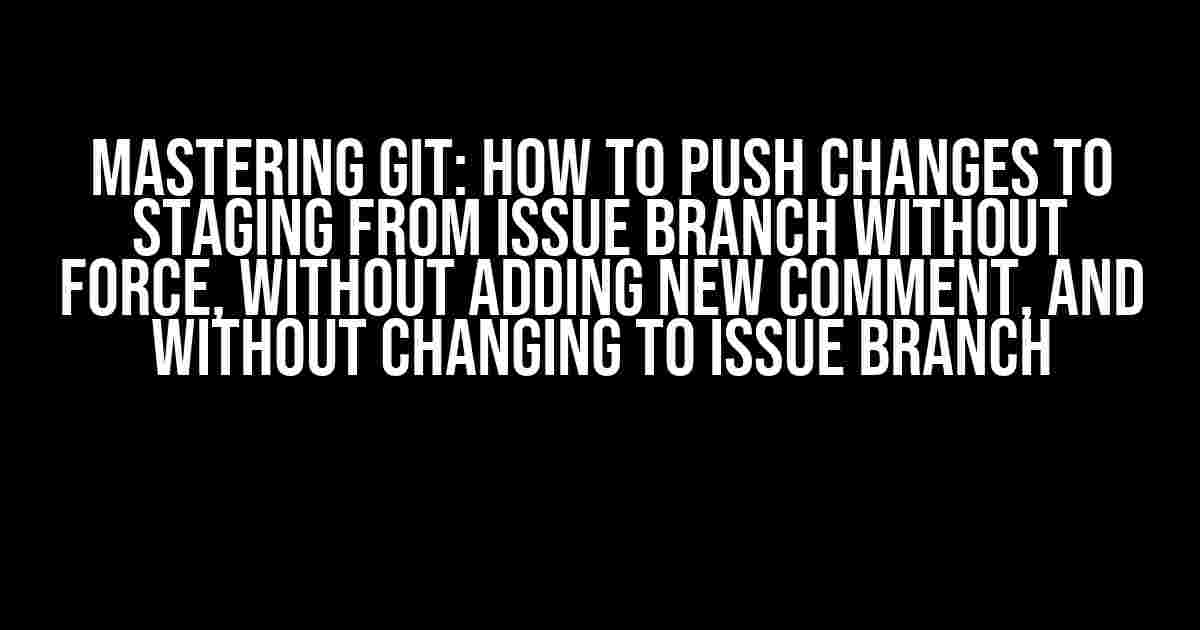As a developer, you’ve probably encountered the frustration of dealing with Git branches. You’re working on a feature, and suddenly, you need to push changes to the staging branch without force, without adding a new comment, and without switching to the issue branch. Sounds like a daunting task, right? Fear not, dear developer, for we’ve got you covered!
Understanding the Problem
Briefly, let’s dive into the reasons why you might want to push changes to staging from an issue branch without using force, adding new comments, or switching branches. :
- Avoid Force Pushing: Force pushing can cause trouble if someone else has pushed changes to the staging branch while you were working on your issue branch. By avoiding force pushing, you ensure that you don’t overwrite others’ changes.
- No New Comments: Adding a new comment can trigger unnecessary notifications and create noise in your Git workflow. By skipping this step, you keep your Git history clean and focused on the actual changes.
- Stay on the Issue Branch: Switching branches can lead to losses in context and momentum. By staying on the issue branch, you maintain your focus and keep working on the task at hand.
The Solution: A Step-by-Step Guide
Don’t worry; we’ve got a solution that’s easier than you think! Follow these steps to push changes to staging from an issue branch without using force, adding new comments, or switching branches:
git checkout issue-branch(Make sure you’re on the issue branch)git pull origin staging(Fetch the latest changes from the staging branch)git merge --no-commit --no-ff origin/staging(Merge staging into your issue branch without committing)git push origin issue-branch:staging(Push your issue branch to the staging branch)git branch -d issue-branch(Delete the local issue branch)
Let’s break down each step to ensure you understand what’s happening:
Step 1: Checkout Issue Branch
git checkout issue-branchYou’re already on the issue branch, so this step is just a formality. You’re ensuring that you’re working on the correct branch.
Step 2: Pull Latest Changes from Staging
git pull origin stagingFetched the latest changes from the staging branch? That’s what this step does. You’re getting the most recent code from the staging branch to ensure you’re up-to-date.
Step 3: Merge Staging into Issue Branch
git merge --no-commit --no-ff origin/stagingThis is the crucial step. You’re merging the staging branch into your issue branch without committing or fast-forwarding. This ensures that you’re not losing any commits or history.
Step 4: Push Issue Branch to Staging
git push origin issue-branch:stagingTime to push your issue branch to the staging branch! You’re essentially moving your changes from the issue branch to the staging branch.
Step 5: Delete Local Issue Branch
git branch -d issue-branchThe final step is to delete the local issue branch. You’ve pushed your changes to staging, so there’s no need to keep the issue branch around.
Common Scenarios and Troubleshooting
Life is rarely straightforward, and you might encounter some hiccups along the way. Here are some common scenarios and troubleshooting tips:
| Scenario | Troubleshooting Tip |
|---|---|
| Error: “Your local changes would be overwritten by merge.” | Use git stash to temporarily stash your changes, then revert to the previous state using git stash pop after the merge. |
| Error: “Merge conflict.” | Resolve the merge conflict by editing the conflicting files, then committing the changes with git commit -m "Resolved merge conflict." |
| Error: “Cannot delete branch ‘issue-branch’ (it is not fully merged).” | Use git branch -D issue-branch to force-delete the branch. |
Conclusion
Voilà! You’ve successfully pushed changes to the staging branch from an issue branch without using force, adding new comments, or switching branches. This workflow ensures a clean and efficient Git experience, free from unnecessary noise and conflicts.
Remember, Git is a powerful tool, and with a little creativity and understanding, you can tackle even the most complex tasks. By following these steps and troubleshooting tips, you’ll be well on your way to mastering Git and streamlining your development workflow.
Happy coding, and don’t hesitate to reach out if you have any questions or need further assistance!
Keyword Bonus: If you’re struggling to remember these steps, try bookmarking this article or printing out the following keyword-rich phrase: “Push changes to staging from issue branch without force, without adding new comment, and without changing to issue branch.”
Frequently Asked Question
Get the lowdown on how to push changes to staging from an issue branch without using force, adding new comments, or switching branches.
What’s the magic command to push changes to staging without using force?
Use `git push origin
How do I avoid adding a new comment when pushing changes to staging?
By default, Git adds a new comment when pushing changes. To avoid this, use `git push origin
Can I push changes to staging without switching to the issue branch?
Yes! You can use `git push origin HEAD:
What’s the correct order of operations to push changes to staging?
First, make sure you’re on the correct branch using `git checkout
Are there any best practices to keep in mind when pushing changes to staging?
Yes! Always make sure you’re pushing changes to the correct branch, and use meaningful commit messages to explain the changes. Additionally, try to keep your commit history clean and linear by avoiding unnecessary merge commits or rewrites.

